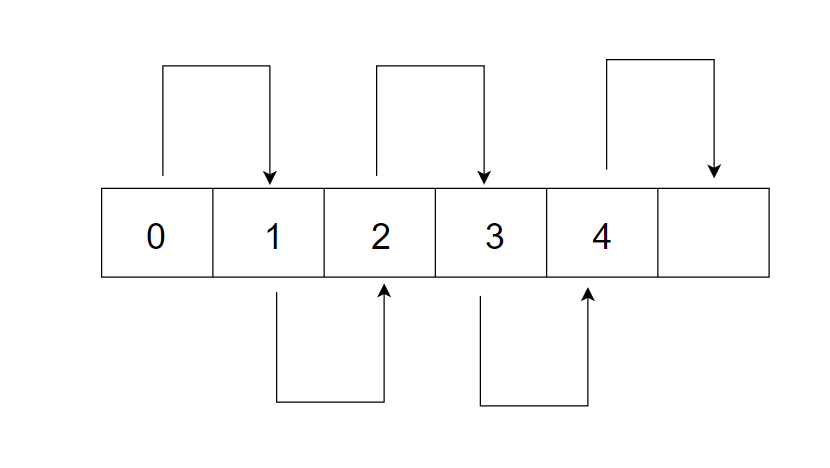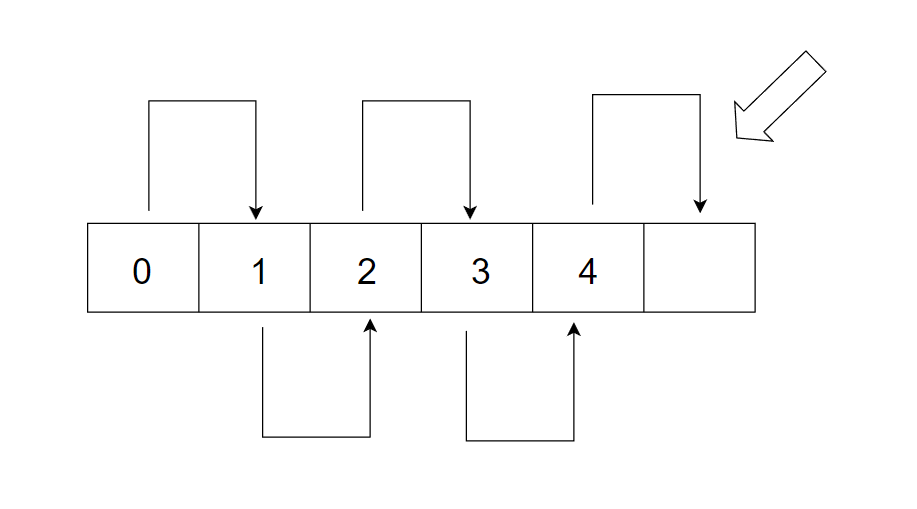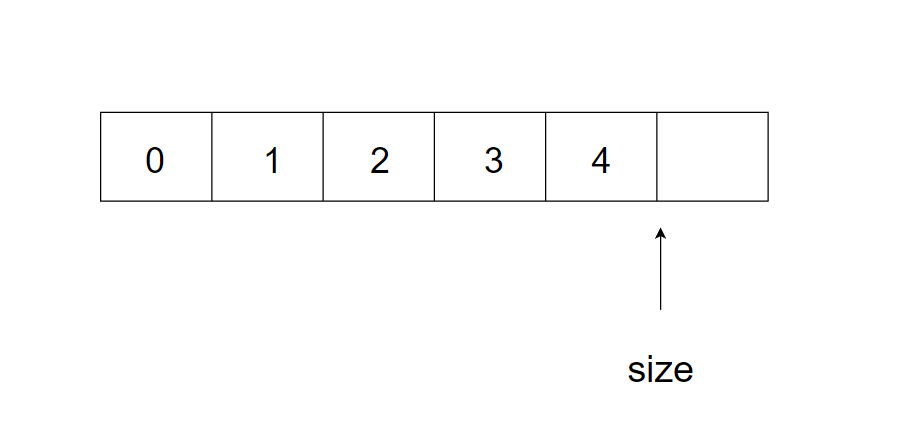目录
既然头与尾部的插入与删除都有,那必然少不了指定位置的插入删除
以上我们完成了顺序表的实现,下一节我们将实现(通讯录)顺序表
书接上文
顺序表的头插(SLPushFront)
头插:

对于头插,我们需要先将数组头部的位置空余出来存放我们需要插入的数x;
所以我们需要将数组中的数向后移一位;
此时:我们有两个思路(数组移位)
1、从下标为0开始向后置换,此时会出现数值覆盖的问题,我们需要另创建一个变量(tmp)存放后一个值以防覆盖之后寻找不到;当tmp的下一个数组为NULL时;怎么办了?
这就要if语句判断或者使用while语句,那有什么方法能将此简化呢:这就来到第二个方法;
2、我们从数组末尾进行移位,这就防止了数值覆盖的问题,还不需要使用到其余语句的创建;
//头插
void SLPushFront(SL* ps, SLDataType x){
//记住SLDataType,这里为我们为了方便(typedef int SLDataType)
assert(ps);//断言一下,防止指针为空
SLCheckCapacity(&ps);//开辟空间
int i = ps->size;
for (; i > 0; i--);//从后往前移位
{
ps->a[i] = ps->a[i - 1];
}
ps->a[0] = x;//此时a[0]就空出来存放x;
ps->size++;//不要忘记size需要++
}顺序表的头删(学会思维的变换)(SLPopFront)
对于头删,我们需要删除下标为0的值,然后将值向前移一位,与头插类似,只不过,此时是从前往后移动;
//头删
void SLPopFront(SL* ps) {
assert(ps);
assert(ps->size);//存放的值不能为NULL;
for (int i = 0; i < ps->size-1; i++) {
ps->a[i] = ps->a[i + 1];
}
ps->size--;
}顺序表的尾插(SLPushBack)
当我们学会了头插,顺序表的尾插相对我们来说,简直轻而易举
尾插:我们就要先判断是否还有空余位置,就要利用SLCheckCapacity(SL* ps);是否需要扩容

此时ps->size的位置如图所示,我们就可以直接将x的值赋给当前位置,然后ps->size++;
//尾插
void SLPushBack(SL* ps, SLDataType x) {
assert(ps);
void SLCheckCapacity(SL * ps);
ps->a[ps->size++] = x;
//相当于ps->a[ps->size] = x;
//ps->size++;
}有尾插就有尾删
思考一下,尾删,我们将ps->size-1的位置删除:将其置为NULL,ps->size--,就完成了尾删;
那我们换一个思路,我们只将这个位置删除,是否可以,直接ps->size--呢:因为当我们打印的时候只需打印[0,size)之间的数,size这个位置需要打印吗?当然不用啦;如果我们需要尾插的时候呢,我们可以直接将此位置覆盖掉;
//尾删
void SLPopBack(SL* ps) {
assert(ps);
assert(ps->size);//进行尾删,必须存在尾删的值
ps->size--;
}既然头与尾部的插入与删除都有,那必然少不了指定位置的插入删除
查找目标值
对于查找数组中的值时,一般使用遍历查询;
//查找
int SLFind(SL* ps, SLDataType x) {
assert(ps);
for (int i = 0; i < ps->size; i++) {//对数组进行遍历
if (ps->a[i] == x) {
return i;
}
}
return -1;//循环结束,没有找到,返回-1;
}指定位置插入(SLInsert)
指定位置插入与头插相似,需要将指定位置后的值向后移移位,在进行插入;
//注意:这里的pos对应数组下标
//指定位置插入
void SLInsert(SL* ps, int pos, SLDataType x) {
assert(ps);
assert(pos >= 0 && ps->size > pos);//pos必须在含有值之间插入
//插入数据:空间够不够
SLCheckCapacity(ps);
//让pos及之后的数据整体往后挪动一位
for (int i = ps->size; i > pos; i--)
{
ps->a[i] = ps->a[i - 1];//a[pos+1] = a[pos]与头插具有相似之处,导致值的覆盖
}
ps->a[pos] = x;//这里的pos对应,数组下标,如果不对应,则按情况+-;
ps->size++;
}指定位置删除(SLErase)
//删除指定位置的数据
void SLErase(SL* ps, int pos)
{
assert(ps);
assert(pos >= 0 && pos < ps->size);
//与头删类似
for (int i = pos; i < ps->size - 1; i++)
{
ps->a[i] = ps->a[i + 1];
}
ps->size--;
}打印(顺序表的结尾之声)
这里我们要注意结构体访问成员的方式 ( . ) ( -> )
void SLPrint(SL s)//对于打印数组,这里不再需要传地址,而是传值
{
for (int i = 0; i < s.size; i++)
{//对于结构体的使用 (.)与(->)的不同
printf("%d ", s.a[i]);
}
printf("\n");
}完整顺序表代码
seqlist.h
#pragma once
typedef int SLDataType;
#include<stdio.h>
#include<stdlib.h>
#include<assert.h>
typedef struct SeqList
{
SLDataType* a;
int size; // 有效数据个数
int capacity; // 空间容量
}SL;
//初始化和销毁
void SLInit(SL* ps);
void SLDestroy(SL* ps);
void SLPrint(SL* ps);
//扩容
void SLCheckCapacity(SL* ps);
//头部插?删除 / 尾部插?删除
void SLPushBack(SL* ps, SLDataType x);
void SLPopBack(SL* ps);
void SLPushFront(SL* ps, SLDataType x);
void SLPopFront(SL* ps);
//指定位置之前插?/删除数据
void SLInsert(SL* ps, int pos, SLDataType x);
void SLErase(SL* ps, int pos);
int SLFind(SL* ps, SLDataType x);seqlist.c
#define _CRT_SECURE_NO_WARNINGS
#include<stdio.h>
#include"seqlist.h"
//typedef int SLdataTapy;
//#define N 10
//
//typedef struct seqlist {
// SLdataTapy arr[N];//定长数组
// int size;//有效数组个数
//}SL;
//typedef int SLdataTapy;
//
//typedef struct seqlist {
// SLdataTapy* a;//用来开辟动态内存
// int size;//有效数组个数
// int capacity;//剩余容量;判断是否需要新添加内存
//}SL;
//初始化和销毁
void SLInit(SL* ps) {
ps->a = NULL;
ps->size = ps->capacity = 0;
}
void SLDestroy(SL* ps) {
if (ps->a) {//判断数组中是否为空
free(ps->a);//因为需要使用malloc,所以需要注意释放内存
}
ps->a = NULL;
ps->size = ps->capacity = 0;
}
//扩容
void SLCheckCapacity(SL* ps) {
//先要判断内存够不够
if (ps->size == ps->capacity) {
//使用malloc relloc celloc
int newcappacity = ps->capacity == 0 ? 4 :ps->capacity*2;//一般增容原来内存的二到三倍;
SLDataType*tmp = (SLDataType*)relloc(ps->a,newcappacity * sizeof(SLDataType));
//注:这里没有直接使用ps->a直接申请,是为了防止内存申请失败;防止数据丢失
if (tmp == NULL) {//也可以使用assert直接终止程序;需要使用aseert.h的头文件
perror("relloc fail");
exit(1);//直接退出程序;也可使用return;
}
//空间增容成功
ps->a = tmp;
ps->capacity = newcappacity;
}
}
//头插
void SLPushFront(SL* ps, SLDataType x) {
//记住SLDataType,这里为我们为了方便(typedef int SLDataType)
assert(ps);//断言一下,防止指针为空
SLCheckCapacity(&ps);//开辟空间
int i = ps->size;
for (; i > 0; i--);//从后往前移位
{
ps->a[i] = ps->a[i - 1];
}
ps->a[0] = x;//此时a[0]就空出来存放x;
ps->size++;//不要忘记size需要++
}
//头删
void SLPopFront(SL* ps) {
assert(ps);
assert(ps->size);//存放的值不能为NULL;
for (int i = 0; i < ps->size-1; i++) {
ps->a[i] = ps->a[i + 1];
}
ps->size--;
}
//尾插
void SLPushBack(SL* ps, SLDataType x) {
assert(ps);
void SLCheckCapacity(SL * ps);
ps->a[ps->size++] = x;
//相当于ps->a[ps->size] = x;
//ps->size++;
}
//尾删
void SLPopBack(SL* ps) {
assert(ps);
assert(ps->size);//进行尾删,必须存在尾删的值
ps->size--;
}
//查找
int SLFind(SL* ps, SLDataType x) {
assert(ps);
for (int i = 0; i < ps->size; i++) {
if (ps->a[i] == x) {
return i;
}
}
return -1;
}
//指定位置插入
void SLInsert(SL* ps, int pos, SLDataType x) {
assert(ps);
assert(pos >= 0 && ps->size > pos);//pos必须在含有值之间插入
//插入数据:空间够不够
SLCheckCapacity(ps);
//让pos及之后的数据整体往后挪动一位
for (int i = ps->size; i > pos; i--)
{
ps->a[i] = ps->a[i - 1];//a[pos+1] = a[pos]与头插具有相似之处,导致值的覆盖
}
ps->a[pos] = x;//这里的pos对应,数组下标,如果不对应,则按情况+-;
ps->size++;
}
//删除指定位置的数据
void SLErase(SL* ps, int pos)
{
assert(ps);
assert(pos >= 0 && pos < ps->size);
//与头删类似
for (int i = pos; i < ps->size - 1; i++)
{
ps->a[i] = ps->a[i + 1];
}
ps->size--;
}
void SLPrint(SL s)//对于打印数组,这里不再需要传地址,而是传值
{
for (int i = 0; i < s.size; i++)
{//对于结构体的使用 (.)与(->)的不同
printf("%d ", s.a[i]);
}
printf("\n");
}以上我们完成了顺序表的实现,下一节我们将实现(通讯录)顺序表
看到这里就点个赞走吧!!!























 6552
6552











 被折叠的 条评论
为什么被折叠?
被折叠的 条评论
为什么被折叠?








